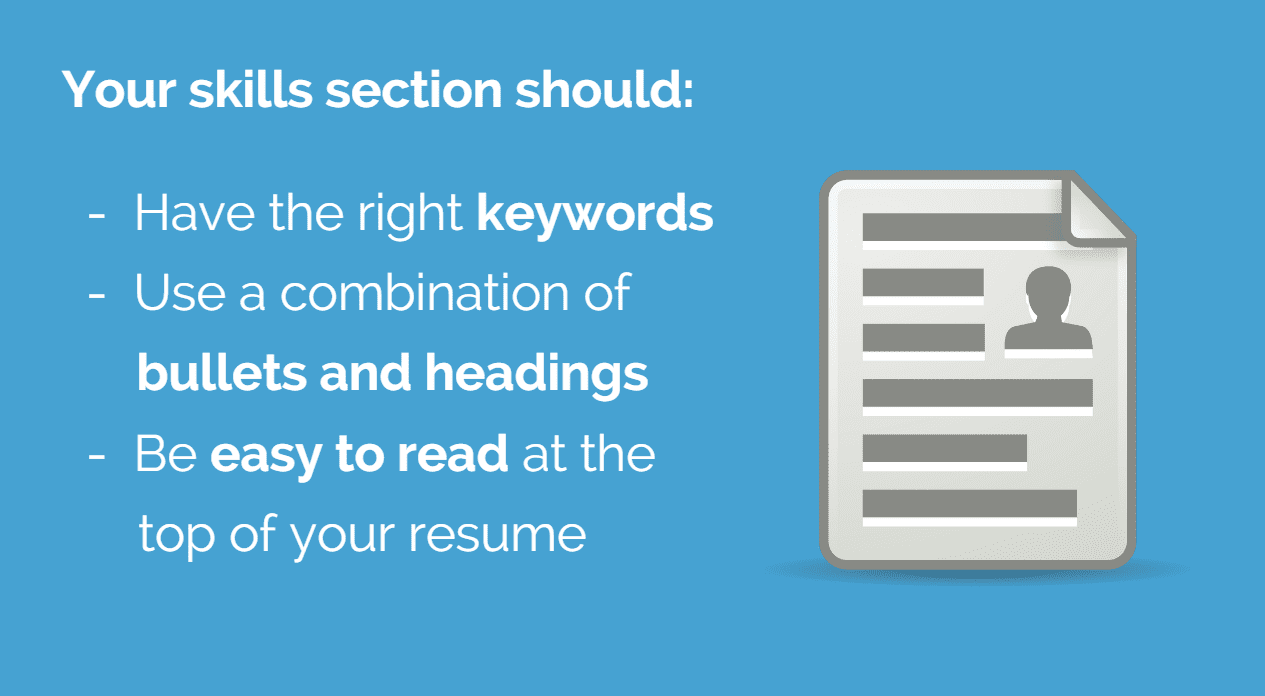 As you start to create or make edits to your resume, an area that may be overlooked for its importance is the skills section. Clearly, your skills need to be properly highlighted throughout your resume, but it’s also crucial to specifically list the skills you have in order to better stand out as an applicant.
As you start to create or make edits to your resume, an area that may be overlooked for its importance is the skills section. Clearly, your skills need to be properly highlighted throughout your resume, but it’s also crucial to specifically list the skills you have in order to better stand out as an applicant.
Why You Need a Skills Section
The skills section of your resume is an area that will allow recruiters and hiring managers to quickly get a better sense of your skillsets. Your skills list will add specific keywords to your resume. As you are writing and trying to keep your resume as concise as possible, this section will act as a great reference and feature your overall hard skills in one easy-to-read space.
How to Create a Skills Section
Keywords
When creating your skills section, only focus on your hard skills. Your soft skills should be highlighted throughout your resume and not specifically listed. The skills listed in this section should also only truly speak to the job you are applying for.
Formatting
It’s important to keep this section near the top of your resume and not hide it at the end so that the recruiter or hiring manager will notice it immediately. In order to make this area most effective, use a reasonable amount of categories that aren’t complicated and keep similar skills in specific groups.
Layout
Since you want to make your resume as easy as possible to review, create your skills section using a variety of lists, bullets, and subheadings. Ensure the layout matches the rest of the formatting you’ve used across your resume.
Examples to Use
The purpose of your skills section is to show the variety of skills you have that make you qualified for the job at hand. Here are several examples to reference when you are generating yours:
Administrative Skills
– Microsoft Office: Word, Excel, PowerPoint, Outlook, Visio
– Languages: English and Spanish
Human Resources Skills
– Recent Training: Strategic Human Resource Planning, Coaching for Human Resource Professionals, Leadership Development
– Affiliations: Society for Human Resource Management, National Human Resources Association, American Staffing Association
Financial Skills
– Accounting Experience: Knowledge of GAAP, Account Reconciliation, Financial Systems, Accounts Payable, Accounts Receivable
– Software: QuickBooks Pro, Microsoft Excel, Microsoft Access, Elite, SAP
Social Media Skills
– Social Networks: Facebook, Twitter, LinkedIn, Instagram, Pinterest, Google+
– Social Management Tools: Buffer, Feedly, Hootsuite, IFTTT, Tweetdeck
Technical Skills
– Operating Systems: Windows 7, Windows 8, Windows XP, Mac OS X, Linux
– Languages: Java, JavaScript, XML, HTML, C#, C++
As you can see, each of these types of skills can be broken down into several categories. The names of your skill categories do not have to be complex and should be easy to recognize. If you want to include additional skills that you are currently learning, mention them in a cover letter or during a phone screen. You only want to include skills that you currently have and are most comfortable utilizing on the job.
 When writing your resume, actually take some time to think about the assortment of skills you possess and the best ways to display them in this section. Although it really only takes a few minutes to create a skills section, it provides significant benefits for getting noticed as a skilled applicant.
When writing your resume, actually take some time to think about the assortment of skills you possess and the best ways to display them in this section. Although it really only takes a few minutes to create a skills section, it provides significant benefits for getting noticed as a skilled applicant.
Interested in other ways to land your next job? Subscribe to the JOHNLEONARD blog below in order to receive even more advice to help with your job search.
